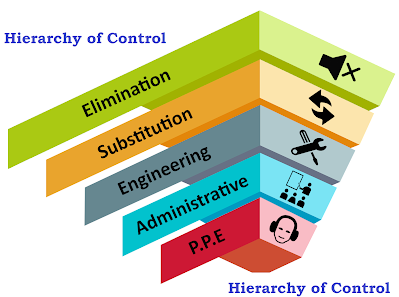"Effective HSE Management:
A Guide to Implementing the
Hierarchy of Control"
The
Hierarchy of Control is a systematic approach for identifying and implementing
controls to eliminate or reduce the risk of harm in the workplace. It is used
in Health, Safety and Environmental (HSE) management to prioritize the most
effective control measures to minimize the risk of harm. The hierarchy of
control is a widely accepted framework used to ensure that the most effective
controls are implemented first, and that less effective controls are only used
as a last resort. This article will discuss the elements of the hierarchy of
control and how it can be used to effectively manage HSE risks in the
workplace.
The
hierarchy of control is often represented as a pyramid, with the most effective
controls at the top, and the least effective controls at the bottom. The five
levels of the hierarchy of control are:
Elimination:
This is the most effective control measure and involves removing the hazard or
risk entirely. For example, eliminating a hazardous chemical from the
workplace.
Part 4 - ADNOC & GULF HSE Interview
Substitution:
This involves replacing a hazardous material or process with a less hazardous
one. For example, replacing a toxic chemical with a less toxic alternative.
Engineering
controls: This involves making changes to the work environment or equipment to
reduce the risk of harm. For example, installing ventilation systems to control
exposure to hazardous dusts or fumes.
Administrative
controls: This involves developing procedures, policies, and training to
minimize the risk of harm. For example, implementing safe work procedures for
handling hazardous materials.
Personal
protective equipment (PPE): This is the least effective control measure, and is
only used as a last resort. PPE is used to protect workers from hazards that
cannot be eliminated or controlled through other means.
It is
important to note that the hierarchy of controls is not a one-time solution,
rather it is a continuous process that requires regular monitoring, review and
updating of
control
measures to ensure they remain effective. The ultimate goal is to achieve the
highest level of control possible, starting with elimination and working down
through the levels as necessary.
The
hierarchy of control can be used in a variety of HSE management contexts,
including workplace safety, environmental management, and occupational health
management. In each context, it can be used to identify and prioritize control
measures that will most effectively manage the risks associated with the
hazards.
One of the
key advantages of using the hierarchy of control is that it helps to ensure
that the most effective control measures are implemented first. This can help
to minimize the risk of harm to workers, the environment, and the community,
while also being cost-effective.
Another
advantage of the hierarchy of control is that it helps to ensure that all
possible control measures are considered. This can help to ensure that the most
appropriate controls are selected, and that less effective controls are only
used as a last resort.
In
conclusion, the hierarchy of control is a systematic approach for identifying
and implementing controls to eliminate or reduce the risk of harm in the
workplace. It is used in Health, Safety and Environmental (HSE) management to
prioritize the most effective control measures to minimize the risk of harm.
The five levels of the hierarchy of control are elimination, substitution,
engineering controls, administrative controls, and personal protective
equipment. It is a continuous process that requires regular monitoring, review
and updating of control measures to ensure they remain effective. Using the
hierarchy of control can help to minimize the risk of harm to workers, the
environment, and the community, while also being cost-effective.
"Effective
HSE Management: A Guide to Implementing the Hierarchy of Control"
Part 2 Electrical Safety Pictorial Guidelines
TOWER, CRAWLER CRANE - PICTORIAL CHECKLIST
Hierarchy
of control, HSE management, workplace safety, environmental management,
occupational health management, risk management, control measures, elimination,
substitution, engineering controls, administrative controls, personal
protective equipment, hazard elimination, hazard reduction.





No comments:
Post a Comment